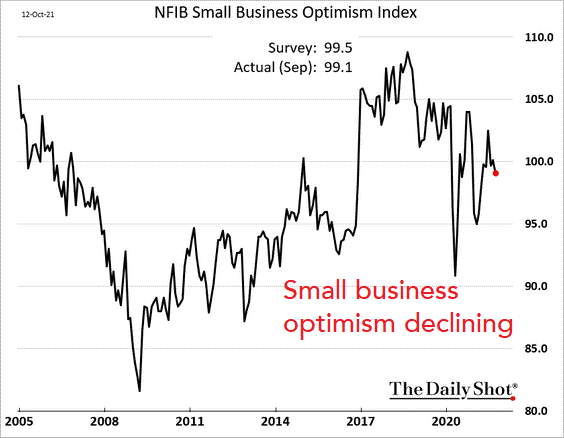Hello all – we hope you had a nice October.
Stocks rebounded nicely this month to close at record highs. The Dow rose 5.8%, the S&P 500 gained 6.9%, and the Nasdaq, which has a higher concentration of technology companies, was up 7.3%.
Stocks rebounded nicely this month to close at record highs. The Dow rose 5.8%, the S&P 500 gained 6.9%, and the Nasdaq, which has a higher concentration of technology companies, was up 7.3%.
In the chart below, you can stocks have traded in a narrow, upward-rising trend that almost looks like a straight line. The sell-off we had in September - the worst month in more than a year - almost ended that trend. However, the gains this month have put the market back in the trend higher. It’s been a rare, remarkable stretch for stocks.
What’s also remarkable is the market has followed its historical average almost perfectly this year. That’s a good sign as the end of the year is typically the strongest period for the market.
There were a few news items behind the rise in stocks this month. First is corporate earnings.
Right now, we’ve heard from about half the companies in the S&P 500 on how they fared in the third quarter - and they’ve done pretty well.
Most companies complained about similar issues - shipping problems and the supply chain, lack of workers, and higher costs. But they’ve been able to raise their prices (or shrink their packaging) to overcome these problems.
The comments from these companies also suggested that these problems are not going away any time soon and costs are likely to be raised even further. That may be good for corporate earnings, but it’s not great for our bank accounts.
Right now, we’ve heard from about half the companies in the S&P 500 on how they fared in the third quarter - and they’ve done pretty well.
Most companies complained about similar issues - shipping problems and the supply chain, lack of workers, and higher costs. But they’ve been able to raise their prices (or shrink their packaging) to overcome these problems.
The comments from these companies also suggested that these problems are not going away any time soon and costs are likely to be raised even further. That may be good for corporate earnings, but it’s not great for our bank accounts.
____
Another item helping the markets was the federal government negotiations over the “infrastructure” bills. There had been talks of raising corporate tax rates to as high as 28% to help pay for the new spending (the rate is 21% currently). However, tax rate hikes are becoming less likely and that was great news for businesses and the market.
Unrelated - we came across a great chart this month regarding corporate taxes. When the tax rate was originally lowered, many pundits were upset that the lower tax rates would cause the government to lose revenue.
However, these lower taxes have actually resulted in a record amount of money going to the government. It shows the formula works: Lower taxes = higher economic growth = more people working and paying taxes = more tax revenue to the government.
This is something to keep in mind as the “infrastructure” debate continues and more tax increases are proposed.
____
The Fed was fairly quiet this month, which also helped the markets. They still appear likely to begin pulling back on their stimulus in November. While it seems widely accepted that they will do this, we don’t think the market is pricing it in. This may bring us some volatility in November.
____
We’ll switch gears to economic data and begin with inflation. Inflation has been a big story recently as energy prices climb to levels that haven’t been seen in years - or ever, in some parts of the world.
Thankfully, energy prices moderated slightly this month, though they don’t seem like they will be losing much ground in the coming months as supply remains low and demand high.
Overall, CPI - which measures inflation at the consumer level - still stands near the highest level since 2008. Inflation at the business level (the PPI) stands at an all-time high.
Economic growth slowed down over the past quarter, too. The GDP report showed 2% growth, making it the lowest print after the covid shut-downs.
We’re hearing the term “stagflation” more and more as inflation rises and economic growth slows.
The employment picture is improving as fewer people apply for unemployment benefits.
Job openings took a turn lower last month, but there’s still more jobs available than there are unemployed people.
Below we’ll show charts of other economic data, which have been either roughly flat or showing modest increases.
Optimism took diverging paths between consumers and small businesses this month. Consumer confidence moved higher:
While optimism with small business owners turned lower:
____
Stocks are on the expensive side in the short run, but have continued to trend higher. Historically, these last two months of the year are very good for the market so this is a nice tailwind. However, we think there is good chance of volatility in November as the Fed pulls back on its stimulus and another debt ceiling fight reemerges. We’d be cautious here.
This commentary is for informational purposes and is not investment advice, an indicator of future performance, a solicitation, an offer to buy or sell, or a recommendation for any security. It should not be used as a primary basis for making investment decisions. Consider your own financial circumstances and goals carefully before investing. Past performance cannot guarantee results.
















